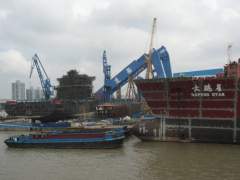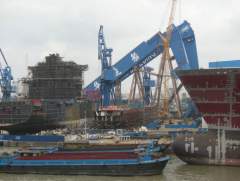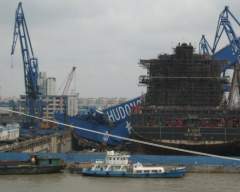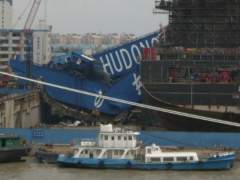-
Posts
3,889 -
Joined
-
Last visited
-
Days Won
149
Content Type
Articles - Top tips for...
Media Demo
Profiles
Blogs
Downloads
Forums
Gallery
Store
Everything posted by smb
-
-
If you think you are having a bad day, take a look at this. It is one of those real "Oh Shit!" moments in history! A bit of a disaster, this one... The blue things were a couple of heavy-lift gantry cranes at a shipyard on the Huang-Pu river, near Shanghai, China。 They have both toppled down onto a large container ship under construction in a dry-dock - and knocked the ship off its blocks and right across to the side of the dock. This photo was taken about 5 or 6 weeks after the incident and dismantling of one of the heavy lift gantry cranes is already underway. What they will do with the ship, I have no idea. (It may be possible to float it and get it back into the middle of the dock, after the wreckage of the gantry cranes has been removed? It could also be a complete write-off and they may even end-up having to break the ship up too, salvage what bits they can and start building a new one?) Whatever. This is one Chinese shipbuilding disaster that is going to cost a LOT of money!! Photo taken from on board c.s. Wave Venture, on passage down the Huang-Pu between Shanghai and Wusong - September, 2008 The ship in the foreground is the Dapeng Star, a gas tanker under construction and the container ship in the dry-dock is the Xin Fei Zhou
- 4 comments
-
3
-
- gantry crane
- Chinese shipyard accident
- (and 8 more)
-

Shipbuilding incident in China - Gantry crane collapse
smb posted a gallery image in Ships, boats and life at sea
If you think you are having a bad day, take a look at this. It is one of those real "Oh Shit!" moments in history! A bit of a disaster, this one... The blue things were a couple of heavy-lift gantry cranes at a shipyard on the Huang-Pu river, near Shanghai, China。 They have both toppled down onto a large container ship under construction in a dry-dock - and knocked the ship off its blocks and right across to the side of the dock. This photo was taken about 5 or 6 weeks after the incident and dismantling of one of the heavy lift gantry cranes is already underway. What they will do with the ship, I have no idea. (It may be possible to float it and get it back into the middle of the dock, after the wreckage of the gantry cranes has been removed? It could also be a complete write-off and they may even end-up having to break the ship up too, salvage what bits they can and start building a new one?) Whatever. This is one Chinese shipbuilding disaster that is going to cost a LOT of money!! Photo taken from on board c.s. Wave Venture, on passage down the Huang-Pu between Shanghai and Wusong - September, 2008 The ship in the foreground is the Dapeng Star, a gas tanker under construction and the container ship in the dry-dock is the Xin Fei Zhou-
3
-
- shipbuilding incident
- collapsed crane
- (and 6 more)
-

Shipbuilding incident, Huang-pu river near Shanghai
smb posted a gallery image in Ships, boats and life at sea
If you think you are having a bad day, take a look at this. It is one of those real "Oh Shit!" moments in history! A bit of a disaster, this one... The blue things were a couple of heavy-lift gantry cranes at a shipyard on the Huang-Pu river, near Shanghai, China。 They have both toppled down onto a large container ship under construction in a dry-dock - and knocked the ship off its blocks and right across to the side of the dock. This photo was taken about 5 or 6 weeks after the incident and dismantling of one of the heavy lift gantry cranes is already underway. What they will do with the ship, I have no idea. (It may be possible to float it and get it back into the middle of the dock, after the wreckage of the gantry cranes has been removed? It could also be a complete write-off and they may even end-up having to break the ship up too, salvage what bits they can and start building a new one?) Whatever. This is one Chinese shipbuilding disaster that is going to cost a LOT of money!! Photo taken from on board c.s. Wave Venture, on passage down the Huang-Pu between Shanghai and Wusong - September, 2008 The container ship in the dry-dock is the Xin Fei Zhou -

Shipbuilding incident, Huang-pu river near Shanghai
smb posted a gallery image in Ships, boats and life at sea
If you think you are having a bad day, take a look at this. It is one of those real "Oh Shit!" moments in history! A bit of a disaster, this one... The blue things were a couple of heavy-lift gantry cranes at a shipyard on the Huang-Pu river, near Shanghai, China。 They have both toppled down onto a large container ship under construction in a dry-dock - and knocked the ship off its blocks and right across to the side of the dock. This photo was taken about 5 or 6 weeks after the incident and dismantling of one of the heavy lift gantry cranes is already underway. What they will do with the ship, I have no idea. (It may be possible to float it and get it back into the middle of the dock, after the wreckage of the gantry cranes has been removed? It could also be a complete write-off and they may even end-up having to break the ship up too, salvage what bits they can and start building a new one?) Whatever. This is one Chinese shipbuilding disaster that is going to cost a LOT of money!! Photo taken from on board c.s. Wave Venture, on passage down the Huang-Pu between Shanghai and Wusong - September, 2008 The container ship in the dry-dock is the Xin Fei Zhou -

Shipbuilding incident, Huang-pu river near Shanghai
smb posted a gallery image in Ships, boats and life at sea
If you think you are having a bad day, take a look at this. It is one of those real "Oh Shit!" moments in history! A bit of a disaster, this one... The blue things were a couple of heavy-lift gantry cranes at a shipyard on the Huang-Pu river, near Shanghai, China。 They have both toppled down onto a large container ship under construction in a dry-dock - and knocked the ship off its blocks and right across to the side of the dock. This photo was taken about 5 or 6 weeks after the incident and dismantling of one of the heavy lift gantry cranes is already underway. What they will do with the ship, I have no idea. (It may be possible to float it and get it back into the middle of the dock, after the wreckage of the gantry cranes has been removed? It could also be a complete write-off and they may even end-up having to break the ship up too, salvage what bits they can and start building a new one?) Whatever. This is one Chinese shipbuilding disaster that is going to cost a LOT of money!! Photo taken from on board c.s. Wave Venture, on passage down the Huang-Pu between Shanghai and Wusong - September, 2008 The container ship in the dry-dock is the Xin Fei Zhou -

Shipbuilding incident, Huang-pu river near Shanghai
smb posted a gallery image in Ships, boats and life at sea
If you think you are having a bad day, take a look at this. It is one of those real "Oh Shit!" moments in history! A bit of a disaster, this one... The blue things were a couple of heavy-lift gantry cranes at a shipyard on the Huang-Pu river, near Shanghai, China。 They have both toppled down onto a large container ship under construction in a dry-dock - and knocked the ship off its blocks and right across to the side of the dock. This photo was taken about 5 or 6 weeks after the incident and dismantling of one of the heavy lift gantry cranes is already underway. What they will do with the ship, I have no idea. (It may be possible to float it and get it back into the middle of the dock, after the wreckage of the gantry cranes has been removed? It could also be a complete write-off and they may even end-up having to break the ship up too, salvage what bits they can and start building a new one?) Whatever. This is one Chinese shipbuilding disaster that is going to cost a LOT of money!! Photo taken from on board c.s. Wave Venture, on passage down the Huang-Pu between Shanghai and Wusong - September, 2008 The container ship in the dry-dock is the Xin Fei Zhou -
The New Drawing on the Right Side of the Brain Author: Betty Edwards Publishers: UK: Harper Collins. Published in the USA by Jeremy P. Teacher / Putnam, a member of Penguin Putnam Inc. Copyright: Betty Edwards 1979, 1989, 1992, 1999 ISBN number: 0 00 711645 4 Other details: 291 pages, mostly in black and white but with one chapter in color. The version reviewed below was a soft-back, approximately 230mm x 191mm x 20mm (9" x 7.5" x 0.7") Available from: In the UK, the book is available from all good book shops. It can also be purchased from amazon.com Book review: In a few words: The perfect book to get you started! Artfreaks.com ratings: Usefulness and practicability: 5 stars Interest and information: 5 stars Attractiveness: 4 stars This book was a real eye-opener for me... Before I picked up a copy of The New Drawing on the Right Side of the Brain, I couldn't draw to save my life. The New Drawing on the Right Side of the Brain is quite heavy on the psychology of drawing (as you might expect from the title!!) But with words of wisdom and encouragement like: "If you have learned how to drive a car, you can learn how to draw!" - and a pretty awful example of one of Van Gogh's early attempts at drawing, you soon get the courage you need to have a go yourself! After many years of procrastination - wanting desperately to have a go at producing my own art but never quite having the courage to take the plunge - this is the book that finally gave me the encouragement that I needed to get started. The New Drawing on the Right Side of the Brain breaks down the barriers that can prevent adults and people in later life from taking up drawing or painting. I particularly like the way that Betty Edwards likens the ability of learning how to draw to the acquired skill of driving a car! She does a very convincing job of proving to the reader that the only real barriers to learning drawing are in the mind - NOT in the hands! One of the first exercises that you will do, if you follow the book, is to copy a drawing upside down... You will be surprised at the results! This is (as you would expect from the title,) more of a book on the psychology of learning to draw - rather than a whole lot of technique. Different techniques and tricks of the trade will get you nowhere if every time you pick up a pencil and paper, you end up with such unsatisfactory results that you just want to give up trying. That is not to say that the author ignores technique altogether... The one I particularly liked and found very useful was "toning" the paper with graphite, before you start and then using an eraser to get the brightest highlights. The proof!: This is a picture of the self-portrait that I done, as instructed by the author, at the start of the couse: I didn't actually get around to doing the "after" portrait, as, now that I have got started, I prefer to copy from photographs. Here's one that I copied from a magazine, shortly after completing "The New Drawing on the Right Side of the Brain: Now I know that I am an ugly bugger - and Faye looks MUCH more attractive than I have drawn her - but, in terms of the drawings themselves, I don't think that there can be much argument about my improvement, after having read the book and worked through some of the exercises. If you work through all of the exercises, and follow the book to the letter, you should be able to make even greater strides in your drawing!
-
Creative Pastel Techniques Forward by: Ian Sidaway Publishers: David & Charles Publishers (August 2001) Copyright: David & Charles Publishers ISBN number: 0715311492 Other details: 128 pages. Hard-back. Full color. Available from: In the UK, the book is available from all good book shops. I bought my copy at the National Bookstore branch in Robinsons, Ermita, Manila. The book can also be purchased online from Amazon.com My attempt at one of the "creative pastel projects" from the book. You can see some more of my early stuff at Members Gallery - My Early Attempts at Pastel Painting Book review: In a few words: A nice book to get you started in pastel painting. I found it very useful, interesting and informative. Artfreaks.com ratings: Usefulness and practicability: 5 stars Interest and information: 4 stars Attractiveness: 4 stars Before I started with any of the worked examples, I read Creative Pastel Techniques from cover to cover. It was a surprisingly good read for an instructional manual!! I found the "creative pastel projects," (worked examples - using different styles, materials and techniques,) very useful indeed. In fact, once I got started with a few of them myself, I found that my enthusiasm for the pastel media had taken on a life of it's own! With a limited amount of time available to me for painting, I soon found more subject matter in the form of newspaper and magazine photographs that I wanted to copy coming my way than I had time for. I persevered with most of the creative pastel projects in the book though - even though the subject matter was not always my first choice - and I found the time well spent in getting a basic grounding in the main techniques. I found the book truly inspirational, highly instructive and well worth the rather high price that I paid for my copy at one of the National Bookstore branches in the Philippines.
-
It's probably a good idea to at least get some confidence in drawing before you try to start painting. The great news is that, as proved by 'Yours Truly', anyone can draw!! I didn't actually realize this until I read The New Drawing on the Right Side of the Brain by Betty Edwards. If you can get hold of a copy and work through the book, I can virtually guarantee that it will give you the confidence to get you started - and you'll be amazed at your own results! This post has been promoted to an article
-
I have had countless problems with pastel fixatives and I have totally ruined many a good painting by using too much of the stuff. The first solution here is to use as little as you can get away with - and never fix your final layer. Just be very careful with the painting until you can get it framed behind glass... However, if like me - (and as suggested in another tip by Jennifer Blenkinsopp) - you like to work in layers; you will definitely not be able to completely avoid using pastel fixatives. My advice here is to simply go for the very highest quality product that you can lay your hands on... For one thing, the price of a very high-quality pastel fixative will put you off using too much of it!! And you will stand much less chance of getting any very undesirable "frosting" effects if you do accidentally use too much. My fixative of choice is the one made for pastels by Senellier. (Senellier also do a very similar fixative which has been formulated especially for charcoal drawings. I find that it also works very well with pastels but it does seem to be a bit lighter - and so you really need to use more of it when working with pastels...) I can not get hold of Senellier fixative in the Philippines but I find that the museum grade varnish, satin, produced by "Golden" suites my purposes quite well. The only real problem that I have with the Golden varnish is that it takes quite a while to dry. But then again, that usually gives me a good excuse to go out for a beer! I buy my Golden varnish at Diovir's in Santa Cruz, Manila I wouldn't touch any of the other so-called fixatives that you can buy in National Bookstore, with a bargepole!!
-
- fixative
- pastel painting
-
(and 2 more)
Tagged with:
-
This tip is from Jennifer Blenkinsopp at ArtWanted.com:
- 1 reply
-
- degas
- past masters
- (and 3 more)
-
Although Rembrandt are generally classed as a soft pastel - personally speaking, I would tend to put them more towards hard end of "soft", if you know what I mean?! (In other words, they are soft - but there are softer pastels out there...) In any case, when you look at the extremely high standard of Jennifer Blenkinsopp's work, you can tell that they obviously work for her! Personally, I much prefer Schmingke and Senellier soft pastels. These are in a different class of softness - a bit like comparing glass with butter!!! I can't find either Schmingke or Senellier pastels in the Philippines, so I buy them every chance I get when I am abroad. Otherwise, I order these very soft pastels online.
- 2 replies
-
- online art supplier
- unison colour
- (and 10 more)
-
This tip is from Jennifer Blenkinsopp at ArtWanted.com: You can view her portfolio here: https://www.artwanted.com/artist.cfm?ArtID=19853
- 2 replies
-
- online art supplier
- unison colour
- (and 10 more)
-
This tip is from Jennifer Blenkinsopp at ArtWanted.com:
- 1 reply
-
- pastel paper
- watercolour paper
- (and 3 more)
-
This tip is from Jennifer Blenkinsopp at ArtWanted.com:
- 1 reply
-
- pastel painting techniques
- painting in layers
- (and 5 more)
-
This is another really useful trick that I learned from a book called "Drawing on the Right Side of the Brain" by: Betty Edwards Tip: (From the book...) Instead of drawing, for example, a man's arm with his hand resting on his hip - look at the space between his arm and his body. Do not look at his arm and do not look at his body. Look only at the space in between his arm and his body... Then draw that space! The same thing applies when it comes to drawing the outside edge of the man's arm... Look at the nearest object to his arm and draw the space between that object and the man's arm! That way, you overcome the tendency of the left side of your brain to make you draw things in the simplified symbol-like images, with which that part of your brain rationalizes the world around you. Then, having overcome this annoying tendency of the left-side of your brain to continually butt-in and interfere with your art - (which is, essentially, a job for the right side of the brain) - you end up easily being able to draw what is actually there - rather than what the left side of your brain would very much like you to draw...!! Try it - you'll be amazed!!
- 2 replies
-
1
-
- drawing on the right side of the brain
- betty edwards
- (and 6 more)
-
Tips on drawing: This tip was the number one lesson that I learned from The New Drawing on the Right Side of the Brain by Betty Edwards If you want to make a drawing from a photograph, just turn the photo upside-down and then copy exactly what you see. Try it. This sounds really stupid but it actually works! The idea here is to confuse the left (rational) side of your brain and prevent it from taking-over your drawing process and making you draw things as the symbols that it sees in. If you leave the drawing or photograph the right way up, the left side of your brain will dive in there and say "Ah! An eye! I know what an eye looks like...!" and then you end up drawing an eye or a face or whatever as you think it should look - rather than the way that it actually looks... There is really nothing very difficult about drawing. Almost anyone with a functioning hand and reasonable eyesight, fingers, paper and a pencil can do it! No special fingers are needed - ordinary ones will do just fine!!!!! And the only skill you need to master is the ability to condition your mind into drawing what is there and not the symbols that the left side of your brain rationalizes in. Just go ahead and give it a try... You'll be amazed at the results! Once you have done this a few times and you start to build your confidence, you'll find that you are able to just copy exactly what you see - (rather than what the left side of your brain thinks you are seeing. Once you have conditioned yourself in this way, you will find that you no longer need to turn your subject upside down... This post has been promoted to an article
-
- drawing
- drawing tips
- (and 4 more)
-
It's probably a good idea to at least get some confidence in drawing before you try to start painting. The great news is that, as proved by 'Yours Truly', anyone can draw!! I didn't actually realize this until I read The New Drawing on the Right Side of the Brain by Betty Edwards. If you can get hold of a copy and work through the book, I can virtually guarantee that it will give you the confidence to get you started - and you'll be amazed at your own results!
-
I have had countless problems with pastel fixatives and I have totally ruined many a good painting by using too much of the stuff. The first solution here is to use as little as you can get away with. Even the absolute best quality fixatives will tend to have a slight dulling effect on the colours and, if you use too much, you will make the surface "frosted" - or even shiny. (And it's quite difficult to apply pastels to a shiny surface!) I want the fixative to bind the pastel particles sufficiently to be able to add a subsequent layer - and nothing more. For this reason, I never use fixative on the final layer... This helps to maintain the vibrancy of the final layer of pastel on the painting. If you choose to follow this method, just be very careful with the painting until you can get it framed behind glass... Building up a pastel painting with several layers - as long as you don't overdo the fixatives - can actually make the painting more vibrant. Unfortunately, though, it's quite hard to build your layers if you are not fixing between the layers... My advice here is to simply go for the very highest quality product that you can lay your hands on... For one thing, the price of a very high-quality pastel fixative will put you off using too much of it!! And you will stand much less chance of getting any very undesirable "frosting" effects if you do accidentally use too much. My fixative of choice is the one made for pastels by Senellier. (Senellier also do a very similar fixative which has been formulated especially for charcoal drawings. I find that it also works very well with pastels but it does seem to be a bit lighter - and so you really need to use more of it when working with pastels...) I can not get hold of Senellier fixative in the Philippines but I find that the museum grade varnish, satin, produced by "Golden" suits my purposes quite well. The only real problem that I have with the Golden varnish is that it takes quite a while to dry. But then again, that usually gives me a good excuse to go out for a beer! I buy my Golden varnish at Diovir in Santa Cruz, Manila I wouldn't touch any of the other so-called fixatives that you can buy in National Bookstore, with a bargepole!!
-
1
-
- art supplies
- varnish
- (and 7 more)
-
This tip is from Jennifer Blenkinsopp at ArtWanted.com:
-
Although Rembrandts are generally classed as soft pastels - I'd put them at the very hard end of "soft." However, when you look at the extremely high standard of Jennifer Blenkinsopp's work, you can tell that they obviously work for her! Personally, I much prefer Schmingke and Senellier soft pastels. These are in a different class of softness - a bit like comparing glass with butter!!! I can't find either Schmingke of Senellier pastels in the Philippines, so I buy them every chance I get when I am abroad. Otherwise, I order these very soft pastels online from MisterArt.com - and have them delivered by FedEx. (Mister Art's prices are very reasonable but I find that I get stung by the customs on delivery...)
-
This tip is from Jennifer Blenkinsopp at ArtWanted.com:
-
This tip is from Jennifer Blenkinsopp at ArtWanted.com:
-
Who's Online 0 Members, 0 Anonymous, 14 Guests (See full list)
- There are no registered users currently online







